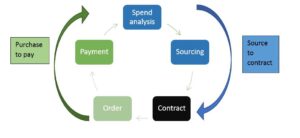Do not use this for corporate presentations! It is just a funny way to explain how mature your team is to your peers
Have you ever tried to explain how good (or bad) your procurement team is to someone who does not understand the terms we use? If he does not understand what streamlining of sourcing and bidding automation is? I used these descriptions. And everyone in the room remembered it 🙂
Let’s dive in…
Level 1: Headless chicken
We have no idea what we are doing. Just trying to survive the day without getting fired. Everything is delayed. We get follow up emails for every order. And we prioritize them based on the level of screaming of our stakeholders. They figured this out, and hence involve their Managers and Director in every, even the smallest thing.
It is a nightmare for the team and the stakeholders. And it is very difficult to get the team out of the mess. They need to clear out the backlog while working on a system that will eliminate the chaos.
Level 2: Now we have a head
We are still doing the same. Just, due to practice and experience, we got better at it. The team learned who is the stakeholder that makes the loudest noise. And sorts his requests out quickly. The team as well knows where to look for certain items. We became more effective. Our ability to process more requests per day increased our output. But still, we are not efficient. We are not using all available tools to make better decisions. And we definitely do not plan or have any kind of strategy.
Level 3: Bring in the measuring tape
We started to monitor and measure. Now we could call ourselves the “Procurement department” as we kinda know what we are doing. In this stage, we compare previous vs. current prices. A market survey is done regularly, and for many requests, we can give a realistic price range in advance. Also, we are doing an analysis of our past purchases. Based on the results, we create a buying strategy. Decide what shall be procured in bulk, and what contracted. While all this is still done manually and in the “old fashion” way using Excel, we have some knowledge of where we have been and where should we go. Or, as a song would say:
” We read the wind and the sky when the sun is high… we know our way”
Level 4: We switched our computers on
The process is streamlined. We do not waste our time any longer creating the same LPO over and over. Catalogues are online, and our stakeholders place the re-occurring orders with one click. The vendors have direct access to our system and use it to submit their bids and invoices. Our analytics provides us insights that we use to optimize our order levels and contracts. The procurement dashboard is live and the management can see what we achieved at any moment. And what is the team doing? We focus on Supplier Relationship Management. Getting the best vendors in, having good deals with them and getting the best value. Furthermore, stakeholders come to us when they have a problem. And we, with help from our vendors, find solutions for the problem.
Finally, we are the “Purchasing department”
Level 5: Actually helping
Now we are the “Sourcing and Procurement” team. We propose new technologies which change the way the company operates. The profit goes up thanks to innovations we brought in with help of our vendors. Our platform that showcases what is new in our industry is read by everyone in the organization.
Our market insights are read by the CEO, as he wants to see where the business will head in the future.
You may ask where is the regular buying here? It is always there, of course. It is just so highly automized and streamlined that now we use about 25% of our working hours for plain purchasing processes. In some cases, a separate tactical procurement team is created, that focuses on day-to-day operations.
This whole description of levels is a result of a discussion with my manager. He asked me how the team is progressing. The answer was:
”Well, we are not any more headless chicken, but as well we do not use the data we have to really plan anything.”
While you can name these levels at your convenience, the basics stay the same. Procurement needs to shift from day-to-day repetitive work. This is not a place where we can provide much value. And this can be done using technology. Once you free your time from the operational tasks, you will have the resources to tackle the strategic questions.
It does not go any other way. Fix the foundations, then build up.
“May the force be with you!”


